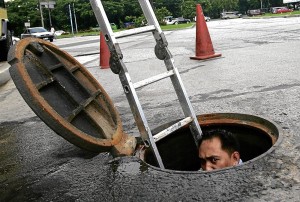
At least this manhole maintained by a water company on East Avenue, Quezon City, was never paved over.MARIANNE BERMUDEZ
No more coverups this time.
Public Works Secretary Rogelio Singson Thursday ordered an immediate investigation into the reported “disappearance” of more than 600 manholes in Metro Manila after they were covered with road asphalt by private contractors working for his department.
This was after the Metro Manila Development Authority (MMDA) blamed such contractors for adding to the cause of flash floods around the capital.
Singson said he had directed DPWH Regional Director Reynaldo Tagudando and district engineers of the National Capital Region (NCR) to inspect areas recently hit by floods to verify the number and location of the “covered manholes.”
“I want them to submit immediately the reports on the inventory of these manholes and identify the negligent contractors and project engineers who are responsible for covering these manholes,” Singson said in a statement.
“We have to be strict on our stand to punish those who are found guilty of such violation, whether they did it intentionally or not,” Singson said.
“The contractors who covered the manholes will be held liable. They will do the clearing and shoulder the work expenses at no extra cost to the government,” he added.
Singson said DPWH officials and employees who are accountable for the work of the contractors will also be penalized, with suspension being the minimum sanction.
“It is no longer business as usual,” he said.
Singson said manholes, especially inlets found on highway gutters, should be kept free from any obstruction, whether garbage or excess asphalt, so as not to impede the flow of floodwaters.
He said DPWH contractors might have rushed work on major thoroughfares recently in time for the 2012 board meeting of Asian Development Bank held in Manila and due to the limited working days on weekends, “but these should not be an excuse to put the quality and safety of our roads and drainage systems at risk.” Philip C. Tubeza